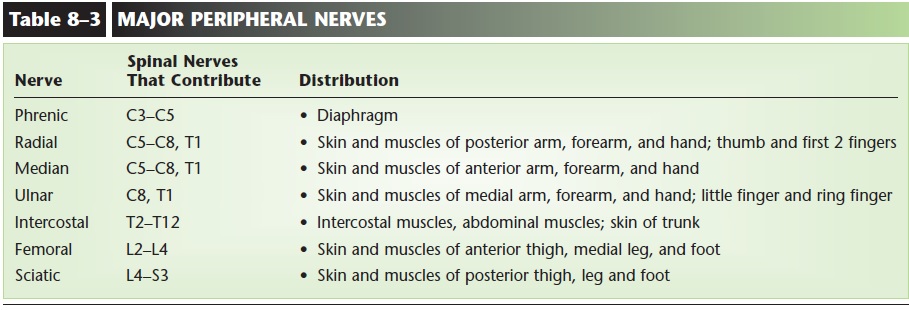Chapter: Essentials of Anatomy and Physiology: The Nervous System
Spinal Nerves
SPINAL NERVES
There are 31 pairs of spinal nerves, those that emerge from the spinal cord. The nerves are named according to their respective vertebrae: 8 cervical pairs, 12 tho-racic pairs, 5 lumbar pairs, 5 sacral pairs, and 1 very small coccygeal pair. These are shown in Fig. 8–4; notice that each nerve is designated by a letter and a number. The 8th cervical nerve is C8, the 1st thoracic nerve is T1, and so on.

In general, the cervical nerves supply the back of the head, neck, shoulders, arms, and diaphragm (the phrenic nerves). The first thoracic nerve also con-tributes to nerves in the arms. The remaining thoracic nerves supply the trunk of the body. The lumbar and sacral nerves supply the hips, pelvic cavity, and legs. Notice that the lumbar and sacral nerves hang below the end of the spinal cord (in order to reach their proper openings to exit from the vertebral canal); this is called the cauda equina, literally, the “horse’s tail.” Some of the important peripheral nerves and their destinations are listed in Table 8–3.

Each spinal nerve has two roots, which are neurons entering or leaving the spinal cord (see Fig. 8–3). The dorsal root is made of sensory neurons that carry impulses into the spinal cord. The dorsal root gan-glion is an enlarged part of the dorsal root that con-tains the cell bodies of the sensory neurons. The term ganglion means a group of cell bodies outside the CNS. These cell bodies are within the vertebral canal and are thereby protected from injury.

The ventral root is the motor root; it is made of the axons of motor neurons carrying impulses from the spinal cord to muscles or glands. The cell bodies of these motor neurons, as mentioned previously, are in the gray matter of the spinal cord. When the two nerve roots merge, the spinal nerve thus formed is a mixed nerve.
Related Topics